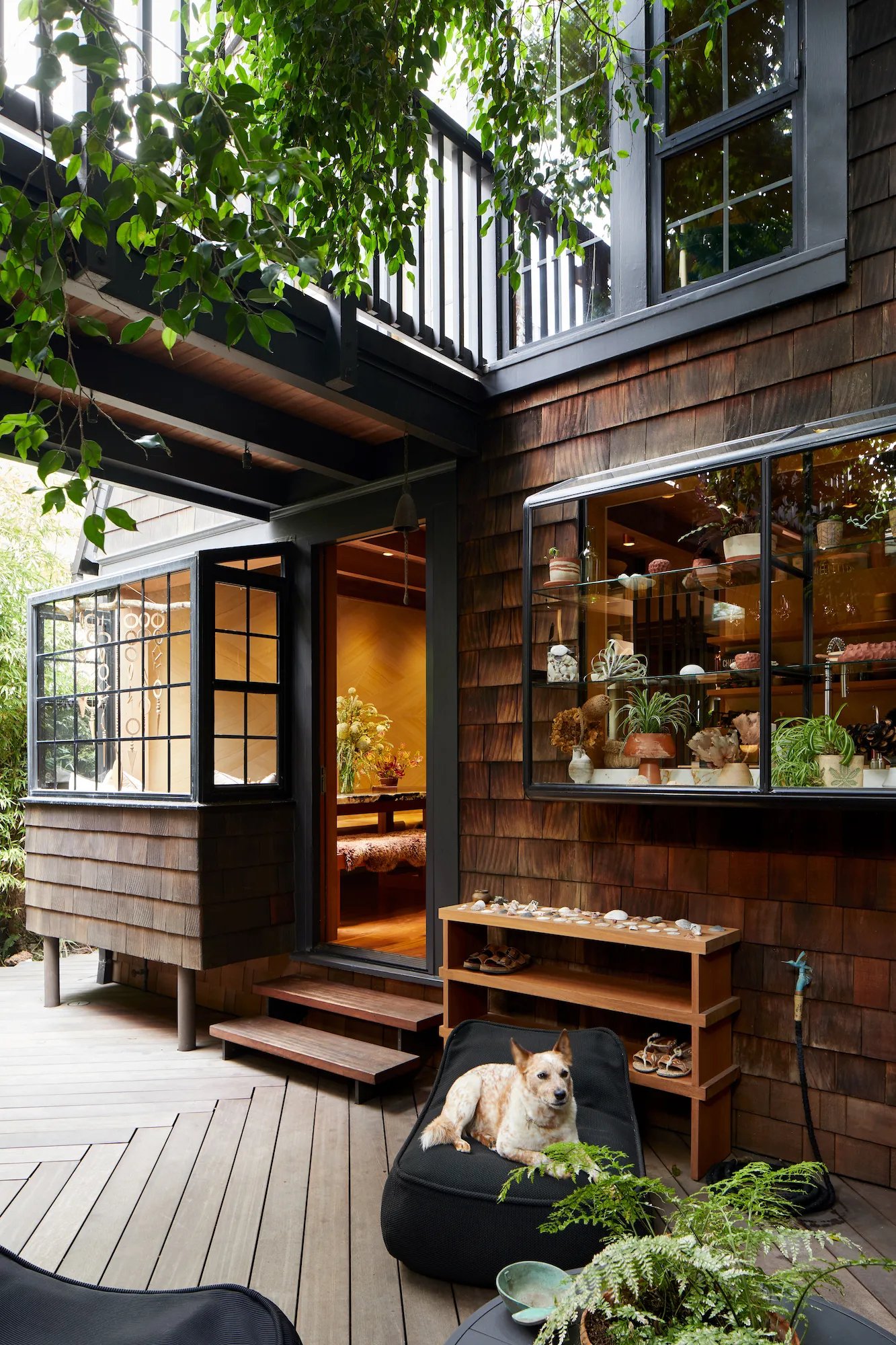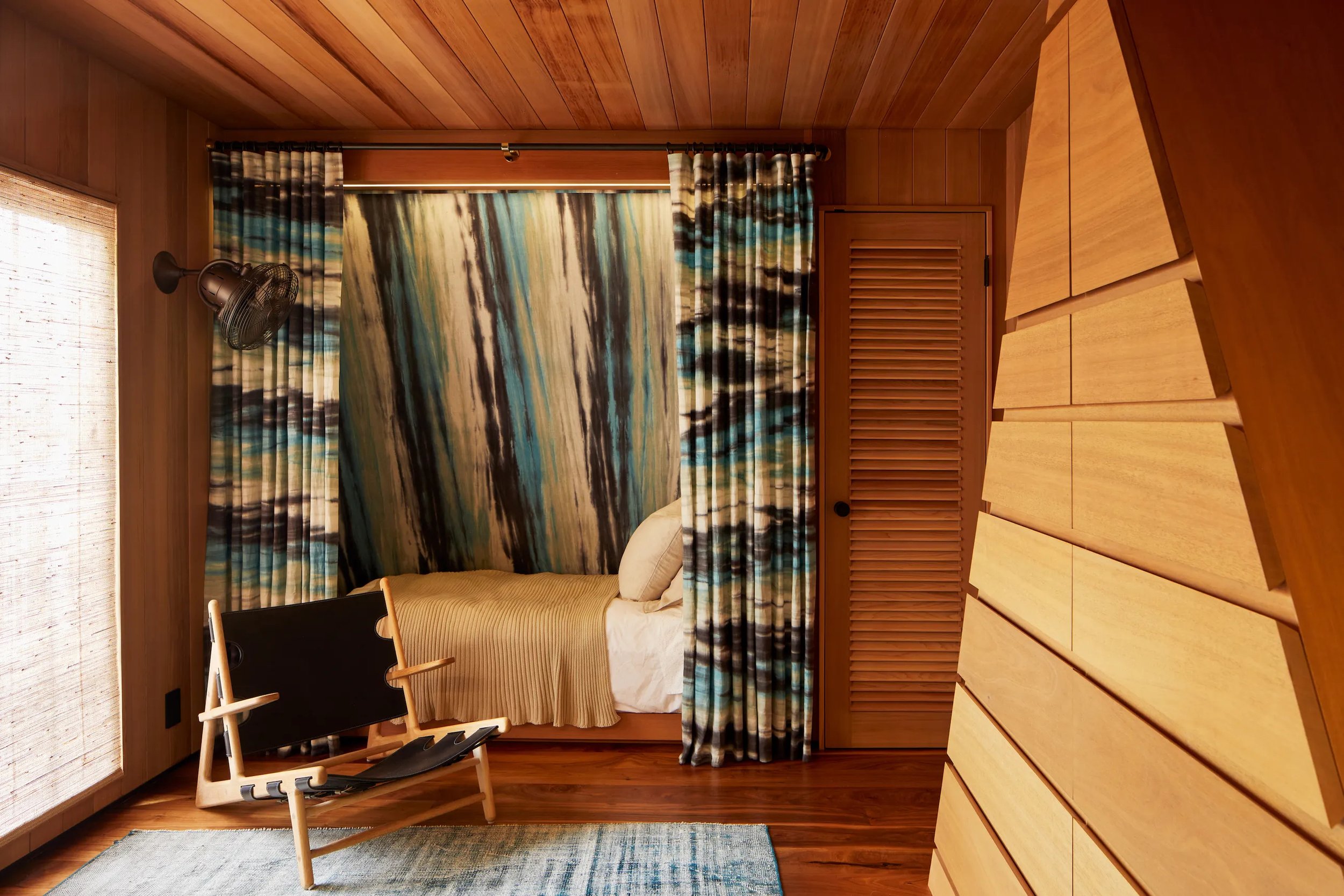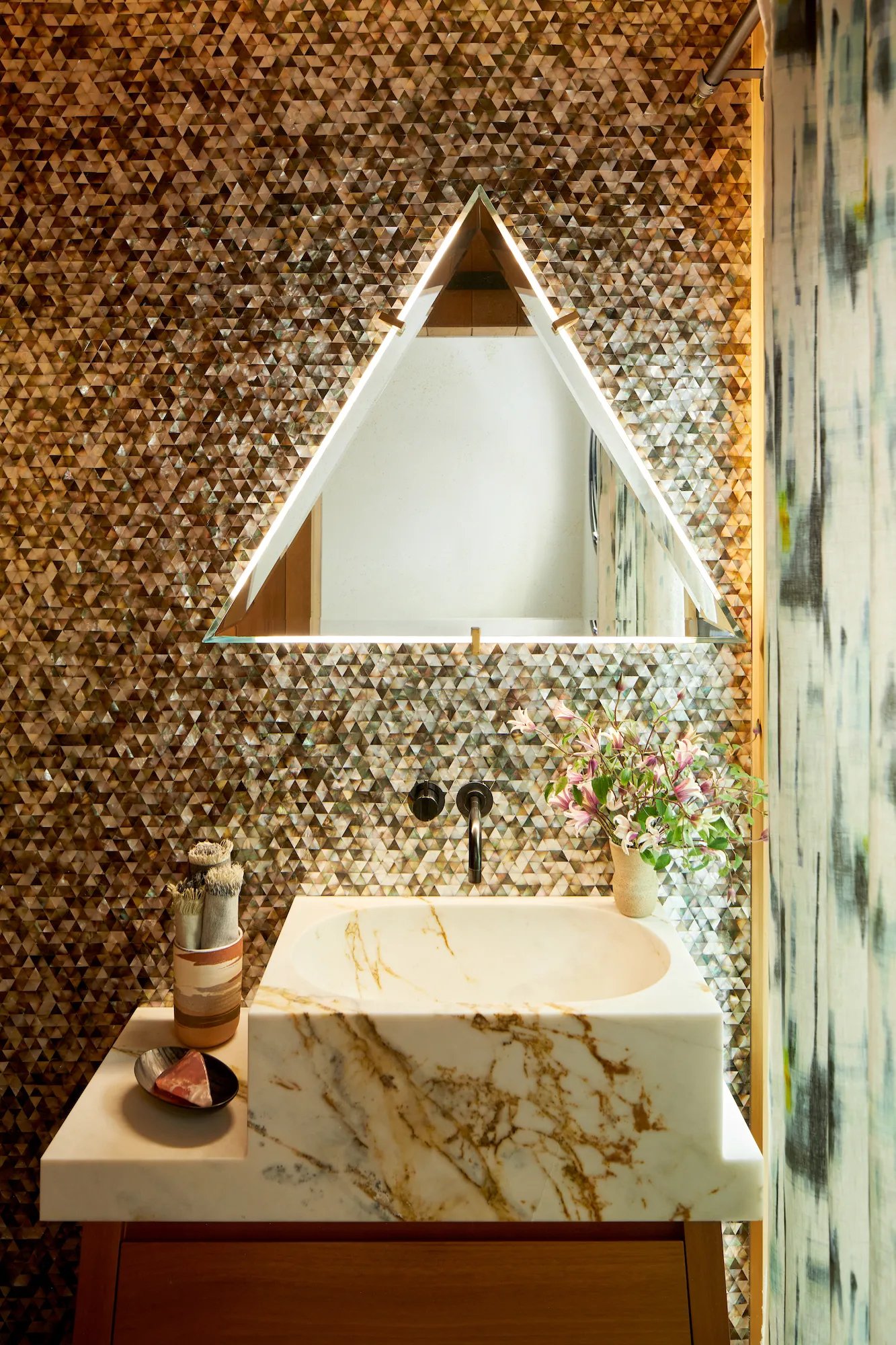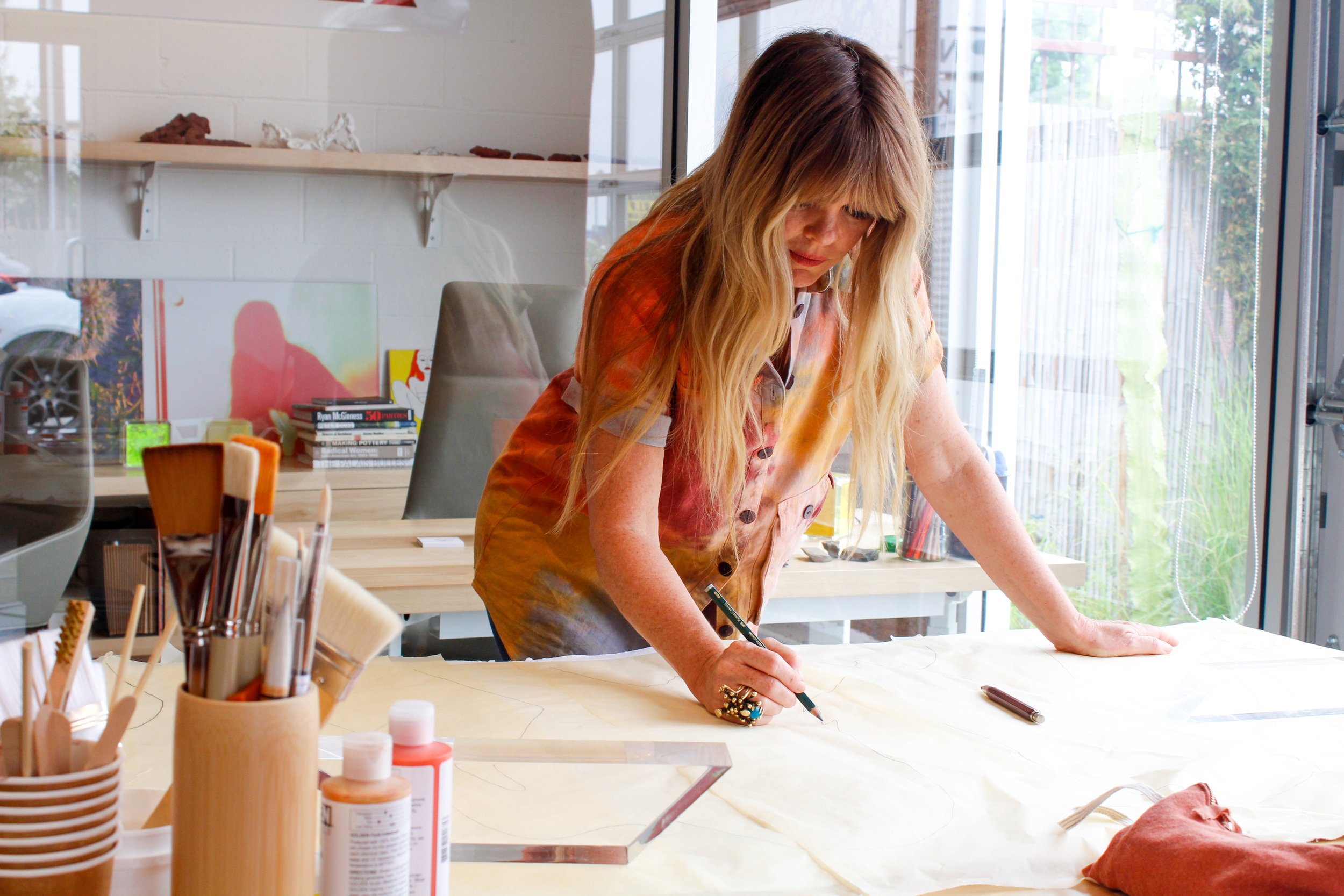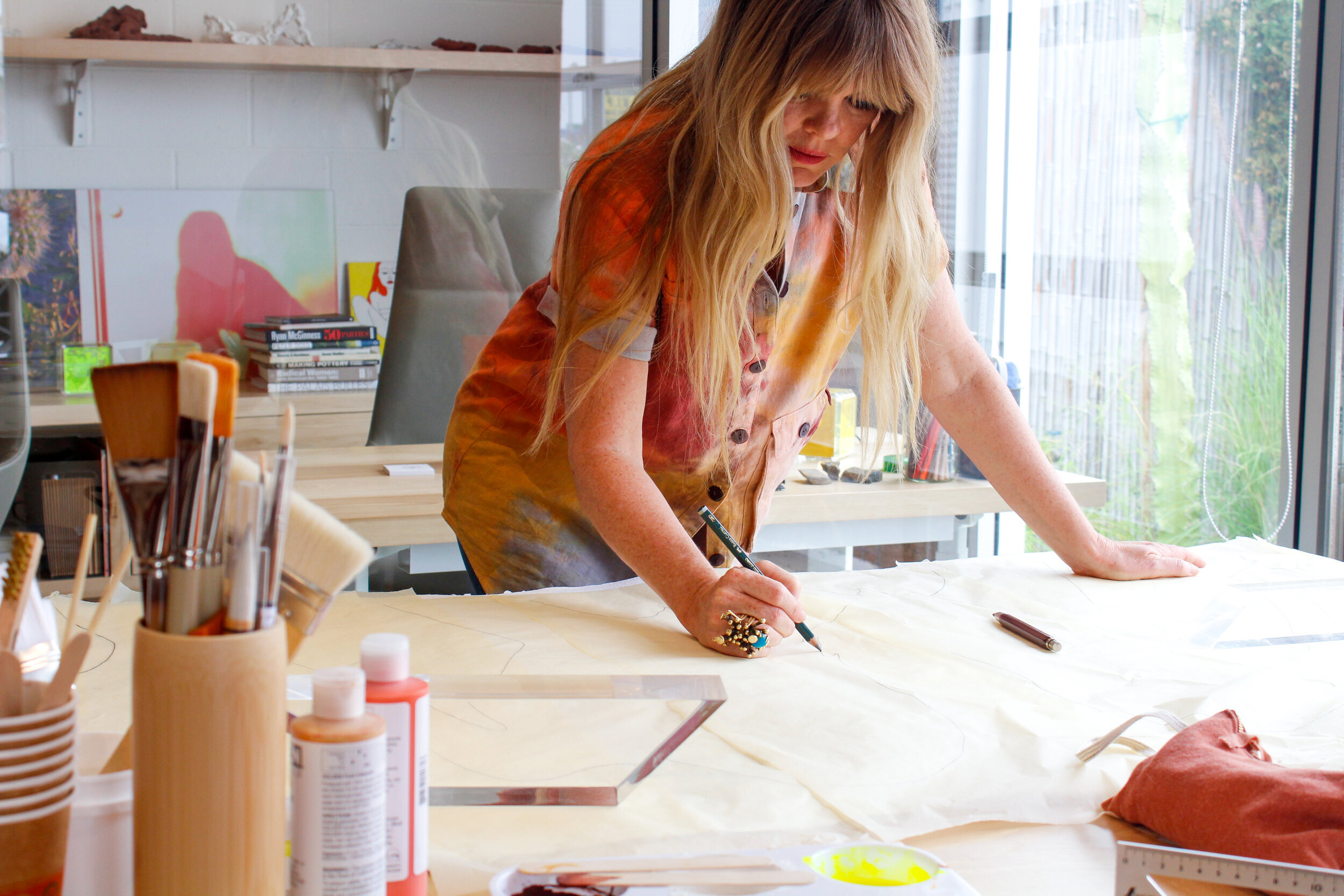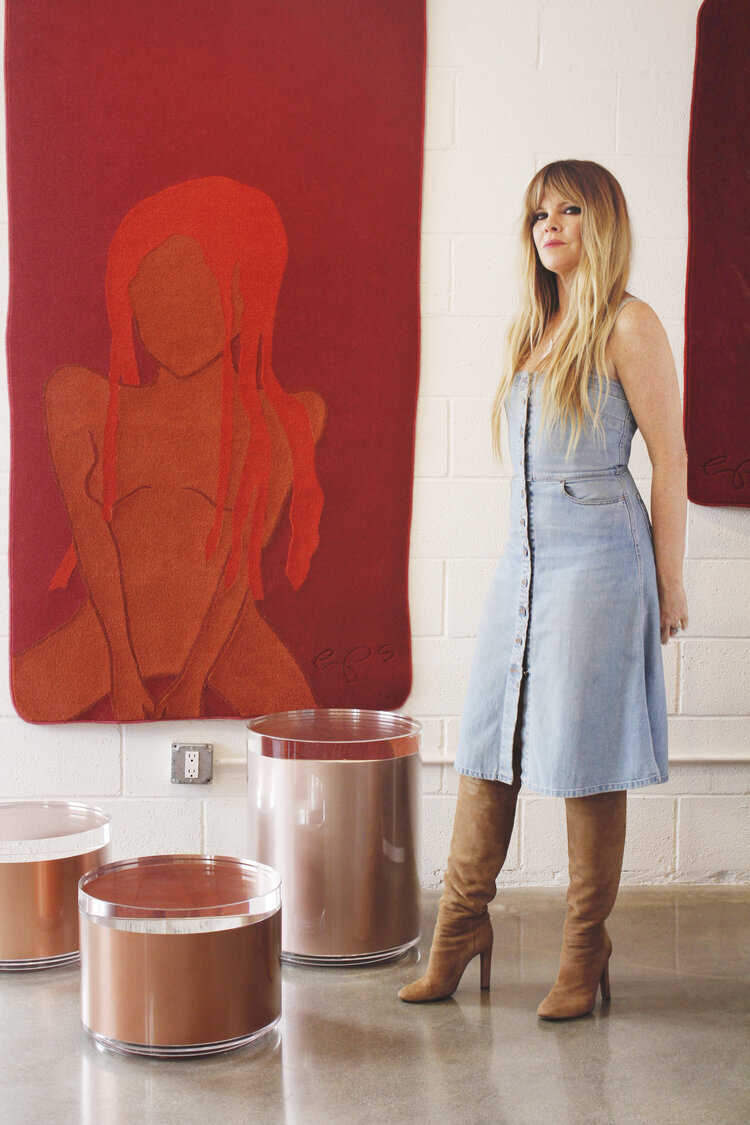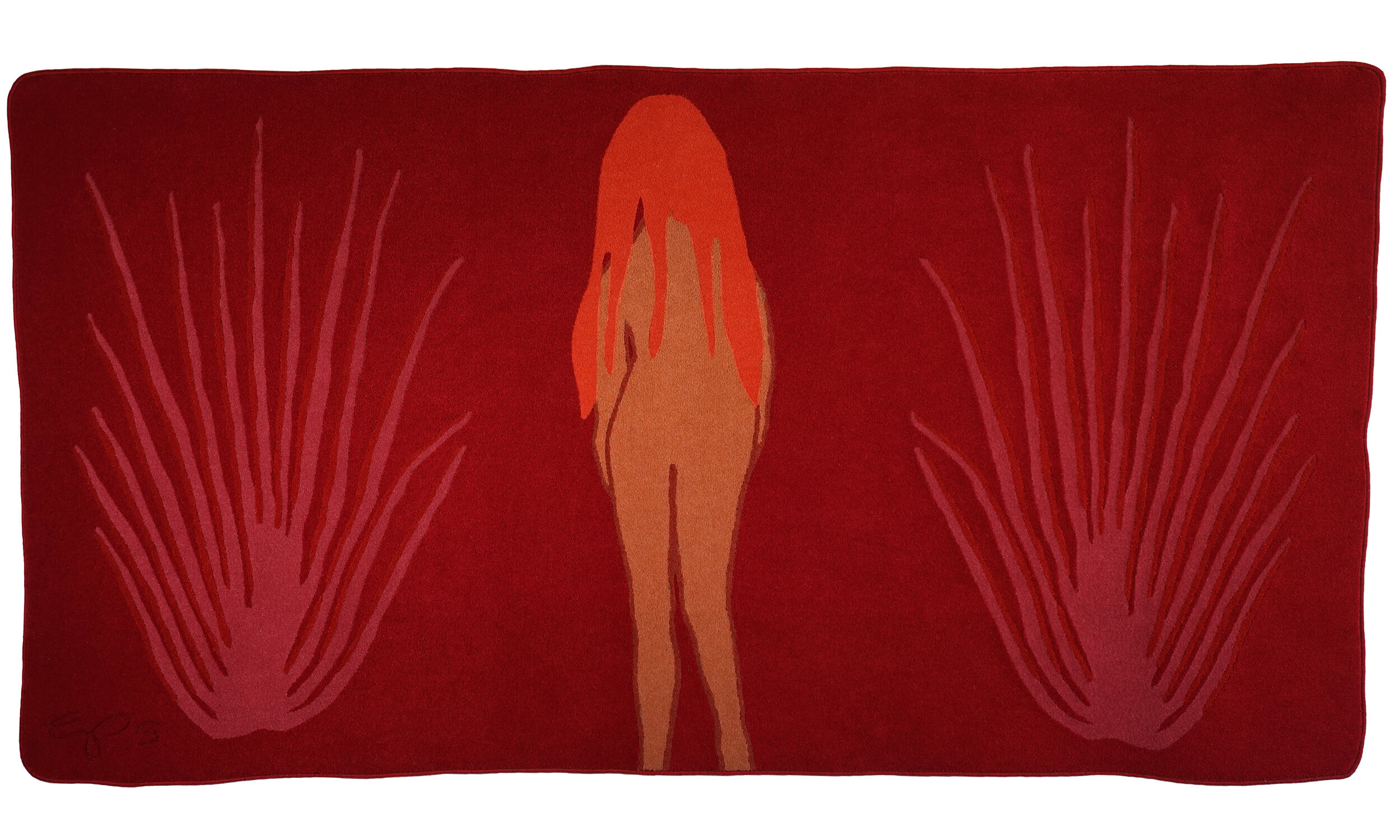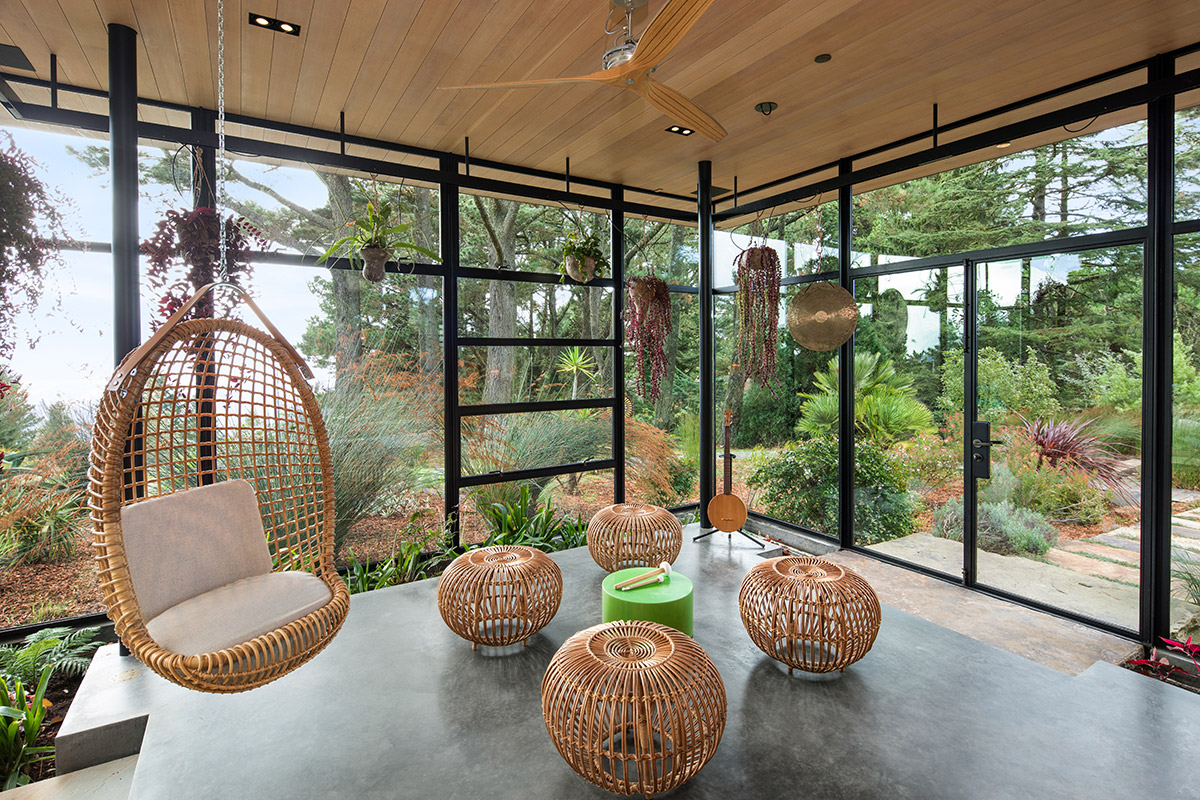Architectural Digest
ARCHITECTURAL DIGEST
By Nick Mafi, Photography by Ye Rin Mok
Inside the Venice Beach Bungalow of a Former Apple Design Lead
For industrial designer Christopher Stringer and his wife, artist Elizabeth Paige Smith, designing the perfect home meant filling it with objects from their lives
Most people want the design of their home to be the very antithesis of their workspace. But industrial designer Christopher Stringer and his wife, artist Elizabeth Paige Smith, aren’t like most people. The creative duo wanted their dwelling to closely reflect their professional lives. “We’re fortunate because we have obsessions that happen to be our jobs,” says Stringer, a former top designer at Apple. “And the design of our home, the way we live in it, it seeps into our work.” But first, they had to find a home that could match their bold style.
After meeting in 2008, Stringer and Smith moved from L.A. to the Bay Area. “We spent about a decade in seclusion up there,” Smith quips. The artist, who is a self-described beach girl, thought Southern California would be perfect place to find a new home. “I lived [in L.A.] after school, and Chris has always felt a kindred spirit in the area, particularly Venice.” Which is precisely where the couple looked to buy a weekend getaway. Through a friend in real estate, they happened upon a 1927 California bungalow in Venice. “The moment we saw it, we thought, ‘This is exactly what we’ve been looking for,’” Stringer explains.
In 2018, after two years of renovation, the couple decided to turn the home into their primary residence. “We fell in love with it as something that wasn’t intended as our full-time residence,” Stringer says. “But we experienced a noticeable lifestyle change in this home. It became our sanctuary.” The couple felt it was important for the home to maintain its quintessential Venice Beach architecture. They didn’t touch the exteriors, and instead they shifted their creative rigor to the interiors of the space.
“We both felt a really strong desire to preserve the house, maintaining its original bones. We were not interested in building a box, as the newer developed homes here tend to strip away a lot of the culture of Venice,” Smith explains. This meant creating ephemeral and almost glowing rooms filled with cedar, walnut, and mahogany wood, Smith’s stunning art, and Stringer’s eye for aesthetic yet functional design. (Before he left Apple in 2017, Stringer greatly contributed to the design of the PowerBook, iMac, iPod, iPhone, iPad, MacBook, Apple Watch, Apple Pencil, and HomePod. Nowadays, his triphonic speaker design, Syng, is what’s making waves, and those globular fixtures make a few appearances in the home.)
Designing the interiors for two ultra-creative people would prove to be the major task in transitioning this home from a charming Venice abode into a highly stylized space. “The house is the chain of experiences we bury ourselves in, how we want to feel, where we want to be, how we build the story of the day,” Stringer says. “We really resonate with waking up with natural light, so above our bed we carved out a skylight. This starts our day with the sky straight overhead, which may sound invasive, but it gives us a signal of what the day is going to be like.”
If the second-floor primary bedroom is full of natural light, the first floor is more muted and intimate. “Christopher grew up in Australia, and I grew up on an island, so we’re both drawn to the idea of these remote oases,” says Smith, who was raised in the Cayman Islandsbefore going to the University of Kansas (or as she says, “moving from one island to another”). “We were conscious of maintaining the original garden windows throughout the first floor,” Smith continues, “which not only draw the light in, but also bring more of the nature in as well. This, in effect, is not only a response to the original architecture, but also to our shared upbringings.”
Though the couple is fully aware that the interiors they’ve designed are intended for their usage in the moment, both feel the history of the nearly century-old space. “Sometimes when I look at a part of the home, I think, ‘Perhaps this is getting closer to the feel of how it was originally intended,’” Stringer says. “We all participate in every part of a home to different degrees, but there’s this constant rigor to get to the sense of feeling that every space is right.”
1/16
Homeowners Christopher Stringer and Elizabeth Paige Smith stand by their front entrance, which consists of tri-fold doors by La Cantina. Above them is a ceramic overhead lighting by Stan Bitters. Redwood steps lead into the entryway.
2/16
The family dog, Woody (an Australian cattle dog), sits near Venice shoe rack shelves in solid mahogany wood by artist and homeowner, Elizabeth Paige Smith.
3/16
A tripod book stand by Marc Newson holds a David Hockney book published by Taschen. In the garden window, custom ceramic Thumb pots are by Smith.
Art: Elizabeth Paige Smith.
4/16
The primary bedroom features a DC Bed by Vincenzo De Cotiis, sheets and a throw by Parachute, a custom goat skin rug by Pure Rugs, and a fan by Boffi. The custom-built Infinite Vibrations Mirror was designed by Smith, as were the three crystal lights (in collaboration with Robert Lewis Lighting). The star of the bedroom, however, is the custom-built steam shower, which was designed by the homeowners. Above the steam shower is a skylight that, with a click of the button, opens to the outdoors. “When you’re in there, it’s like you’re in a courtyard. But really, you are outside, in the middle of the bedroom,” Stringer says.
Art Left: Mulga the Artist. Art Right: Paul McNeil.
5/16
The study features a Chevron Writing Table in Aqua and Custom Chess Board, both by Smith. The vintage chess pieces are by Carl Aubock.
Art: Elizabeth Paige Smith.
6/16
Inside of the zen room, artwork by Smith adorns the walls. The ceramic ceiling lighting was made by Stan Bitters, and it gives the walnut flooring and cedar wood walls a calming amber glow.
8/16
The dining room consists of a mahogany wood and stone top table, a chess board designed by Smith, and a hanging ceramic artwork by Heather Levine.
9/16
The guest room features a Pyramid Commode in mahogany by Smith, a hunting chair by Borge Mogensen, and drapery and upholstery on the wall by Romo.
10/16
The primary suite includes a Ofurò bathtub by Rapsel, designed by Matteo Thun & Antonio Rodriguez. The artwork is by Smith. The bath towels are by Parachute.
Art Left: Crowds with Shape of Reason Missing: Example 3, 2012 © John Baldessari. Courtesy Estate of John Baldessari © 2022 Courtesy Sprüth Magers.
11/16
The living room includes a sofa designed by Francesco Binfaré and Stringer’s Syng Cell Alpha speakers. There’s a nude dining chair in chocolate by Smith. An original 1970s Gufram Green Cactus coat rack adds a vibrant splash of color.
12/16
This powder room features both a Venice Vanity I in California Calcutta stone and mahogany wood, and a piece from the Infinite Vibrations III mirror series by Smith.
13/16
This corner includes the homeowner’s work: a natural leather custom bench by Smith and a Syng Cell Alphaspeaker by Stringer.
14/16
Inside the kitchen is a vintage iron and leather wine rack by Arthur Umanoff sitting atop custom milled California Calcutta stone.
15/16
The living room includes Alchemy Sound Bowls that sit atop Smith’s White Diamond table, a Pouf chair, and a cowhide rug by Pure Rugs.
16/16
The hammock (sourced through Coquicoqui) draws in the eye as a nouveau hearth in the room. A yellow pedestal table and blue pedestal table, both by Smith, add splashes of color.
Find the full article here
Stay Connected
FLAUNT
Meet the multidisciplinary artist making new waves in the art world while getting the attention of celebrity furniture collectors.
Written by Joshen Mantai
Artistic Shapeshifting in Equilibrium
While the collective isolation and ensuing mania from the reality of the past nine months has gotten to almost everyone’s mental health—artist Elizabeth Paige Smith is mostly unfazed. She has seized the chaos of quarantine as an opportunity to take a “deep dive into communications,” viewing social media as an advantageous tool for creative possibility. Smith is a renowned furniture designer and artist with a coveted studio on Lincoln Boulevard in Venice, collectors of her high-end tables and vortex commodes amongst the likes of celebrities Gwyneth Paltrow, Kanye West, Kirstin Dunst, and Patricia Arquette. Her unique sensitization to textures, the environment, light, and overall ability to break free from the pressurized conformity of contemporary art have earned her exhibition spots in the Smithsonian Cooper Hewitt National Design Museum, amongst many others. Smith was impressionably featured in the first “Made in California” exhibition at LACMA, along with Sam Maloff and Frank Gehry. FLAUNT had the opportunity to sit down with Smith over Zoom to discuss her search for creative opportunity amidst quarantine, artistic values, and future projects.
Prior to the origins of the pandemic, Smith relays that she had detailed plans for studio visits that collapsed, which she exclaims set her “spiraling back into the emotional headscape I was in before living in isolation.” Smith had an atypical and unparalleled experience that inadvertently prepared her for the pandemic — living for ten years in isolation at the Frank Lloyd Wright Foundation house in Woodside, just outside of tech-buzzing metropolis Palo Alto. During her time away, Smith found inspiration in the midst of her rekindled connection with nature, creating a series of eight stone sculptures titled “Naked and Fucking Free.” “I’ve always found nature as a source of inspiration,” she explains. “I’ve always contrasted my own feelings and thoughts with nature, and the consistency of nature.” Her inspiration for the eight figurines stemmed from her steady fascination with organic matter and geometric figures, crafting sculptures that portray female figures in their sense of emotional independence, but accompanying vulnerability. Smith describes them as representing an “emboldened feminine state,” describing how she purposefully utilized denotatively masculine materials like stone to contrast the conventional thinking of what it means to be feminine.
Smith’s work can easily be described as feminist—a facet she says she was surprised to realize until her friend pointedly referred to her work as such. She stands behind the assumption, being influenced by a long lineage of strong women in her family who worked within various artistic mediums. She claimed the artistic space of design with utter reverence, soon discovering neither design nor art was an easy territory to traipse into. Despite being fortunate enough to capture the rapid attention of acclaimed publications like the New York Times and being invited to exhibit in Milan and Japan with elite design groups, she noticed the male-dominated nature of the industry. “At the time design was male-dominated, run by a group of guys in New York, and no women in America were participating in global exhibitions,” she remarks. “I felt very isolated and unsupported, aside from a few key people.”
However, this did not stop Smith’s ambitions, as she elucidates that not giving up is “a part of the creative war.” Smith continued to shift gears, looking for opportunity wherever she could find it, redefining artistic expression in her examination of raw emotion in her art. This rawness is on display in her series of woven warm-colored tapestries, named “A Very Long Day,” which takes an intimate glimpse into the sensory overload of challenges faced in cherished relationships. “There’s a lot of gravity in that experience,” she shares. “There can be a lot of inner turmoil, and there’s a spectrum we experience, which I focused on a lot in this work.”
Smith’s potent ability to delineate emotionality within physical raw material is an aspect that originated from her inclinations as a child, making creations with mud in the Cayman Islands, where she grew up. Here, Smith expresses that she sought isolation as a form of comfort, spending most of her time underwater, hyper-aware of details, equilibrium, and weightlessness within her domain. “I feel invincible with equilibrium,” she reflects. “All of your senses are nurtured underwater, so it heightens your awareness. Feeling invincible is having your own forcefield. There was a time when challenges around me were out of my control. I was taxed by others’ chaos, and I developed this concept around my forcefield, where I could create my own equilibrium.”
In her exile of the outside world, Smith says she has developed the “chance to pay attention subtly,” something she encourages of other artists around her. In terms of her future pursuits, Smith sees herself “opening up to a more conceptual realm,” already starting to traverse the juxtaposition of human voice and natural sound in her collection of sound poems titled “Waiting For You,” set in a pristine California poppy field. While what work we see from Smith next may be a surprise, it’s clear her multidisciplinary accolades are only beginning, apparent in her unwavering confidence within the exploration of different media, adaptable to any challenge that dares to come her way.
Find the full article here
See more of Naked + Fucking Free | A Very Long Day
Stay Connected
FORBES
A California Artist Finds Peace In Isolation
FORBES
August 2020
Written by Brienne Walsh
A California Artist Finds Peace In Isolation
A few weeks ago, I had a lovely Zoom call with the artist Elizabeth Paige Smith, who goes by Betsy. Towards the end, she told me that earlier that day, she had stuck her head in a water tower on her six-acre property in Woodside, California, and listened to the sound of her own breath as a form of sound art. As a mother of two young children currently living in a constant state of anxiety, I wished that I could achieve that same zen in my own mosquito-filled backyard in Savannah, Georgia.
For the past ten years, Smith says, she has lived in isolation in a Frank Lloyd Wright Foundation house in Woodside, a wealthy community just outside of Palo Alto. The experience prepared her for the isolation many people have experienced during the COVID-19 pandemic. “I didn’t have any distractions,” she told me. “I was really one with the coyotes, with the hawks. I was in unison with the frogs.”
Before moving to her current home, Smith was a successful furniture designer and curator with an atelier on Abbott Kinney Boulevard. Celebrities including Gwyneth Paltrow, Kanye West, Kirstin Dunst and Patricia Arquette collected her work. The life she led in Venice, while glamorous, distracted her from accessing the sense of equilibrium with nature and her own creativity she had first discovered while a child in the Cayman Islands.
She found it again by chance on the estate where she still lives in the hills above Silicon Valley, which belonged to the man who would eventually become her husband. “I came and experienced such an incredible soul connection, both with him, and with the land itself,” she said. She decided to leave her life in Venice, and merge with her soul mate.
In her decade of isolation, Smith produced a number of bodies of work, among them “Naked and Fucking Free,” a series of anthropomorphic stone sculptures, and “A Very Long Day,” a series of tapestries in burnt sienna and orange that capture, she says, the raw and untamed spirit in every woman.
“Naked and Fucking Free” consists of eight stone sculptures that look like women basking, spread-eagled, or crouched, in the sun. They were inspired by a trip Smith took in 2013 to a stone quarry, where she found stones that looked like the legs of a female figure. Smith, who describes herself as “material curious,” said that she spent the next decade combing quarries in the Pacific Northwest for the perfect stones to complete each of the eight bodies.
“I recognize the material of the stones as being very masculine,” she told me. “I just sort of want to break free and challenge the preconceived ideas of feminine and masculine within the body.”
There is a freedom and wildness to the sculptures. They are also extremely redolent of the work of 20th century sculptors including Josef Pillhofer and Max Bill. It is easy to see Kanye West getting a glimpse of the series, and ordering an army of the spread-eagled women for his ranch in Cody, Wyoming. It’s also easy to see how the series could be inspired by Smith herself, removed enough from human contact that she can truly be in communion with her own personal Garden of Eden.
The woven strands of the tapestries in “A Very Long Day” read like a love story in a song by Joni Mitchell, or a story Joan Didion. A nude woman with very long orange hair appears in tableaus that are alternated with phrases like “feel the warmth,” or “I waited for you all day.” They look like something that someone who collects crystals would very much enjoy having in their sunny mid-century modern home. Smith says she hoped to capture the “guttural” energy all women know they possess, but don’t necessarily know how to channel.
Smith had recently decided to re-emerge from her estate in Woodside, and re-immerse herself in the Venice art scene, when the coronavirus pandemic struck. For now, she’s back in her aerie.
In terms of advice she would give to people experiencing isolation for the first time, she says: “I think the best thing is to find a connection to what really makes you happy. Create boundaries for technology and give yourself space to disengage.”
Find the full article here
See more of Naked + Fucking Free | A Very Long Day
Stay Connected
DWELL
A Creative Couple’s Redwood-Clad Home Draws In Panoramic Bay Area Views
DWELL
July 2020
Written by Brian Libby | Photographed by Benard Andre
A Creative Couple’s Redwood-Clad Home Draws In Panoramic Bay Area Views
Elizabeth Paige Smith and Christopher Stringer’s hilltop retreat is a lucent gem on an impressive perch.
Although the Seeds residence is a delicate fusion of glass and reclaimed redwood—a place where every detail has been thoughtfully considered—owners Elizabeth Paige Smith and Christopher Stringer would be the first to tell you that the story starts with the picturesque site.
At this crest of a forested hill near Woodside, California, beyond the sprawling Silicon Valley megalopolis, it’s possible to see both the Pacific Ocean to the west and San Francisco Bay to the north. Yet the view somehow becomes even more beautiful as visibility decreases.
"When the fog comes up from the ocean, you really experience some incredible drama," says Elizabeth, a visual artist specializing in sculpture, tapestries, and film. "They’re some of the most killer sunsets I’ve experienced." Long before the project was completed, the couple got married at the site in 2013, she adds, "because it’s so special there."
A late addition to the design is the expanded entry, which forms a glass corner to provide a first glimpse into the house while extending a canopy and trellis outward. "That, I think, was a pivotal movement," says Gwise. "It took their concept of the glass box and brought it around to the front to give the house a sense of symmetry.”
Juxtaposed against the glass is the home’s other material signature: the use of reclaimed and naturally-stained redwood, which the project’s builder, Louis Ptak, sourced from an airplane hangar being deconstructed at nearby Moffet Field.
"When we got the first batch, we knew it wasn’t meant to be just an exterior experience," Elizabeth recalls. "We were like, ‘It has to wrap and come inside. The redwood really played a major role in bringing the outdoors in.”
If Elizabeth’s artful eye helped shape the house and site’s renovation, so too did her husband, who spent over two decades as a designer for Apple. That’s how Christopher met first met James Gwise, who spent most of the 2000s at architecture firm Bohlin Cywinski Jackson, designer of many Apple stores. "Chris looks for the simplicity in complicated things," Elizabeth says. "We also connect over the emotional impact of bringing materials together."
Take how the redwood panels line up inside. Even as a door closes, or a Murphy bed in one studio folds into the wall, the pattern remains uninterrupted, as if the bed or door simply disappear. Or consider how the wood walls float above the concrete floors in the new addition. "Everything had to be on module, on rhythm," Gwise says. "Not much was left to chance in this house.”
There are many artful details inside, such as a bathroom sink carved into a massive boulder, for which added structural support had to be built underneath the floor, or a white marble step used as the final transition from the wood stairway to the concrete floor. Which is to say nothing of the bold marble kitchen countertops.
And indeed, the Seeds residence has proven to be inspiring. Elizabeth has created several outdoor sculptures there, using an outdoor area beside the house as a kind of testing ground.
"When making art, I like to go by feel and slowly find my way forward," she says, noting that the Seeds house turned out the same way: a series of continuing conversations that led to a simple concept, exquisitely executed. "It’s a really tight ship," Elizabeth adds. "The spaces and how they flow together really harmonize."




